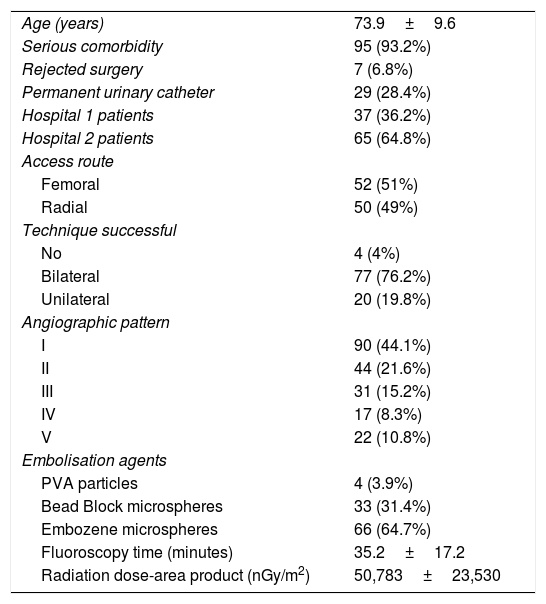To present the results of a multidisciplinary study of two tertiary hospitals, together with urology services, on 102 consecutive patients not candidates for surgery treated for more than 6 years, in whom prostatic arteries were embolised for the treatment of benign hyperplasia.
Material and methodsFrom December 2012 to February 2019, 102 patients with symptoms of benign prostatic hyperplasia (BPH) not candidates for surgery or who explicitly rejected surgery, with an average age of 73.9 years (range 47.5–94.5), underwent prosthetic embolisation. The patients were followed up by questionnaires on urinary symptoms, sexual function and impact on quality of life, as well as measurement of prostate volume, uroflowmetry and prostate specific antigen (PSA) at one, 3 and 6 months and one year following the procedure.
ResultsThe technique was successful in 96% of patients (76.2% bilateral and 19.8% unilateral). The mean duration of the procedure was 92min and of the radioscopy 35.2min. Statistically significant changes were demonstrated (p<.05) in PSA, peak urinary flow, QoL (quality of life) questionnaire and the International Index of Erectile Function (IPSS). PSA had reduced by 58% from baseline at 3 months. Similarly, the Qmax had increased significantly by 63% in the third month following embolisation. A significant improvement in the QoL and IPSS tests was achieved, with a reduction of 3.7 points and a mean 13.5 points, respectively, at one year’s follow-up. Prostate volume showed a non-statistically significant decrease at follow-up of one year following treatment. A series of minor complications was collected, no case of which required hospital admission.
ConclusionsProstatic embolisation for the treatment of BPH proved an effective and safe technique in patients who were not candidates for surgery.
Presentar los resultados de un estudio multidisciplinar de dos hospitales terciarios, junto a los servicios de urología, sobre 102 pacientes consecutivos no candidatos a cirugía tratados durante más de 6 años, en los que se realizó embolización de arterias prostáticas para el tratamiento de la hiperplasia benigna.
Material y métodosDesde diciembre de 2012 a febrero de 2019, 102 pacientes con síntomas de hiperplasia benigna de la próstata (HBP) no candidatos a cirugía o que la rechazaron explícitamente, con una edad media de 73,9 años (rango 47,5–94,5), fueron sometidos a embolización prostática. Se llevó a cabo un seguimiento de estos a través de cuestionarios sobre la sintomatología urinaria, función sexual e impacto en la calidad de vida, así como la medición del volumen prostático, uroflujometría y antígeno prostático específico (PSA) al mes, 3 y 6 meses y al año del procedimiento.
ResultadosLa técnica fue exitosa en un 96% de los pacientes (76,2% bilateral y 19,8% unilateral). El tiempo de duración media del procedimiento fue de 92 minutos y el de radioscopia, de 35,2 minutos. Se demostraron cambios estadísticamente significativos (p<0,05) en el PSA, el flujo urinario pico, el cuestionario QoL (Quality of life) y el International Index of Erectile Function (IPSS). El PSA disminuyó un 58% a los 3 meses respecto al valor inicial. Asimismo, el Qmáx aumentó de manera significativa en un 63% al tercer mes tras la embolización. Se obtuvo una mejoría significativa en los test QoL e IPSS, con una disminución de 3,7 puntos y 13,5 puntos de media, respectivamente, al año de seguimiento. El volumen prostático mostró una disminución no estadísticamente significativa al año, tras el tratamiento. Se han recogido una serie de complicaciones menores, que en ningún caso requirieron ingreso hospitalario.
ConclusionesLa embolización prostática para el tratamiento de la HPB demostró ser una técnica eficaz y segura en pacientes no candidatos a cirugía.













